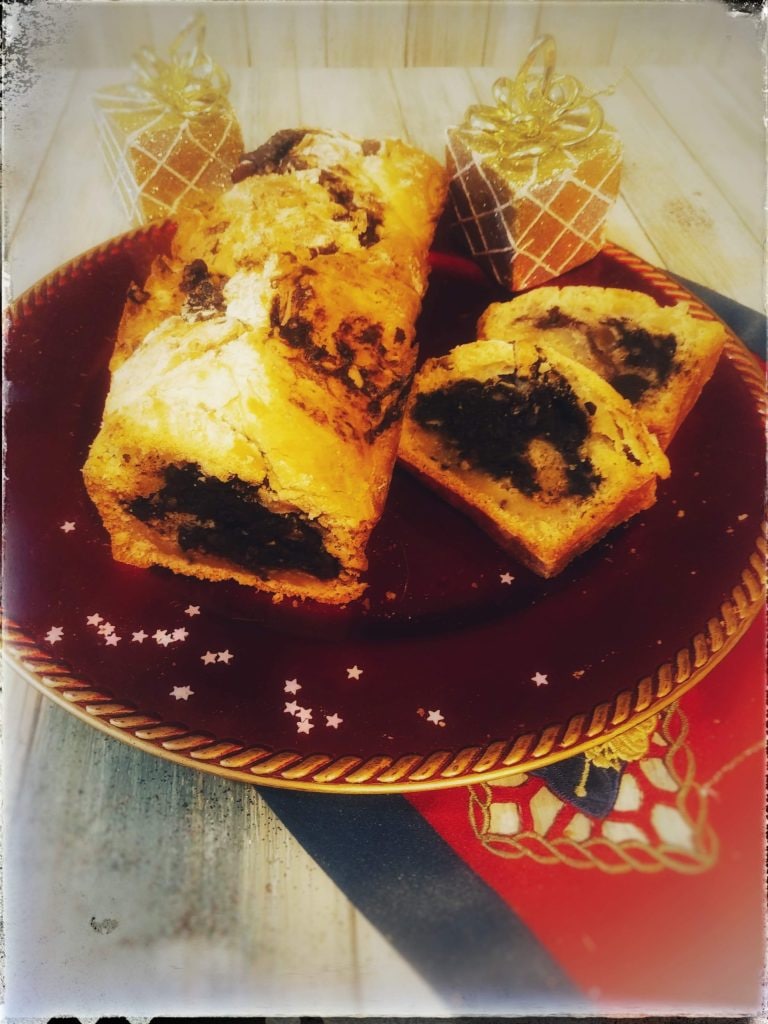Merry Christmas in Romanian is: Crăciun Fericit!
It literally means “Happy Christmas” while Sarbatori fericite! means Happy Holidays.
Among the main gift-bringers in Romania is Moș Nicolae, or “Old Nicholas,” who, according to tradition, makes his appearance on the night of December 5th and 6th, and for the occasion, children leave their clean shoes outside to be filled with gifts.
In the countryside, the tradition of the pig’s sacrifice on December 20th is still respected, and sausage and smoked bacon are made from the meat.
Pork is the star of Romanian Christmas tables.
In Romania, the tree is decorated on Christmas Eve.
Tradition said it was Santa himself who decorated it. Children go “caroling” (from “colindă” typical Romanian Christmas song): they ride on a horse-drawn cart with wooden wheels and, going from house to house, sing Christmas tunes.
At the Romanian Christmas Eve dinner, you cannot miss țuica (a brandy drunk to whet the appetite), sarmale (stuffed minced meat rolls wrapped in cabbage or vine leaves), piftie (garlic jelly containing pig’s feet, ears, and head), șoric (washed and salted pig skin), toba (a huge sausage containing pork’s inner organs seasoned with a bit of mustard), gratar de porc (pork roast).
And to conclude the cozonac, a leavened cake baked in a loaf pan, a sweet bread made with flour, eggs, milk, butter, sugar with a filling of walnuts and cocoa, poppy seeds or dried fruits.
Depending on the region, other ingredients such as raisins, grated orange or lemon peel, walnuts or hazelnuts, and vanilla or rum flavoring may be added.
It is customary to believe that animals speak to each other on Christmas night; therefore, in some areas, people dress up with masks representing bears, wolves, and sheep to approach the real animals and listen to their conversation.
The Cozonac is worked by hand for a long time, rolled or braided incorporating the filling, and baked in loaf pans.
One of the keys to success is to remove the ingredients from the fridge a few hours in advance and maintain a constant temperature during preparation, leavening, and baking, avoiding during this time even opening windows or doors that could cause drafts.
Find other recipes dedicated to Christmas in the collection “Christmas Worldwide“.

- Difficulty: Medium
- Cost: Inexpensive
- Rest time: 6 Hours
- Preparation time: 20 Minutes
- Portions: 8 people
- Cooking methods: Oven
- Cuisine: Romanian
- Seasonality: Christmas, Easter
Ingredients for the dough:
- 2 cups all-purpose flour
- 2 cups Manitoba flour
- 8 tbsps butter (or sunflower oil)
- 1/3 cup milk
- 10 g fresh brewer's yeast
- 2 eggs
- 6 tbsps sugar
- 1/2 tbsp vanilla essence
- 1 tbsp rum
- to taste salt
- 1 1/2 cups walnuts
- 2 tbsps unsweetened cocoa powder
- 2 egg whites
- 8 tbsps sugar
- to taste poppy seeds
- 1 tbsp rum
Cozonac Preparation:
Sift the all-purpose flour and Manitoba flour into a bowl and set aside.
In a small saucepan, pour 50 ml of milk and heat it, then dissolve the brewer’s yeast in it and add 150 g of mixed flour.
Wait for about half an hour for the rising process to begin (pre-ferment).
In the stand mixer bowl, put the flour, add the pre-ferment, eggs, and sugar, the remaining milk, working with the paddle attachment at low speed; once the dough is formed, add the vanilla essence, rum, and when absorbed, work the dough at medium speed until it detaches from the sides of the bowl.
At this point, add the butter in pieces (at room temperature) and continue kneading to achieve elasticity again. If necessary, add a dusting of flour.
Lightly flour the work surface to transfer the dough to it.
Give it a fold by gently spreading it, taking the edges and folding them towards the center, turn the dough over, shape it into a ball with the seam underneath, place it in a floured bowl, cover with food-grade plastic wrap, and let it rise in the refrigerator for at least 5-6 hours.
Prepare the filling:
Finely chop the walnuts.
In a bowl, gather the cocoa, sugar, chopped walnuts, poppy seeds, and rum; mix by adding 2 egg whites until you obtain a sort of paste.
Set aside.
Bring the dough back to room temperature, cut it in half, form balls and roll them out into rectangles.
Stuff by spreading the walnut filling, leaving two centimeters free from the edges; then roll the cylinders, seal them well at both ends and along the edge.
Roll each one lengthwise and then braid spirally, placing the seam of the dough underneath (to give the traditional shape of the cake).
Place in a long rectangular mold, like a loaf pan, lined with parchment paper and let rise for about an hour.
Bake at 350°F for 1 hour.
Let it cool and glaze with a syrup of water and sugar.
Cut it when it is cold.
Affiliate Link #adv
The loaf pan, or plumcake pan, is essential for the successful outcome of the cake. Here you can find a variety made of silicone, suitable specifically for Cozonac.
Is Cozonac prepared only in Romania?
No, Cozonac is common throughout southeastern Europe in countries such as Romania, Moldova, Bulgaria, Serbia, North Macedonia, and Greece.
Rich in eggs, milk, and butter, it is usually prepared for Easter in Romania, Serbia, Bulgaria, and in Romania and Moldova it is also traditional for Good Friday, in a simplified version with vegan ingredients, without eggs or milk – called Cozonac de post – to be eaten by Christians during Lent.
The name derives from the Bulgarian word for hair-коса/kosa, or from Greek: κοσωνάκι, romanized: kosōnáki, a diminutive form of κοσώνα, kosōna.

